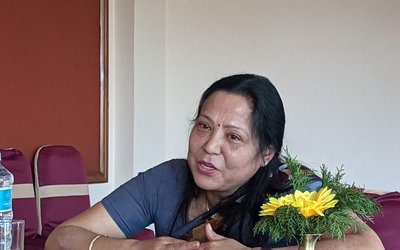
How do you see the state of heritage of Kathmandu Valley following the massive earthquake of April 25?
I cannot explain my feelings in words. The heritage is completely ruined. I am yet to cope with the reality. We need to rebuild and reconstruct our ancient temples and heritage sites cautiously. The destruction and devastation of the temples and monuments were flattened like that had happened in 1934 earthquake. We don't have detailed documents of 1934 great earthquake. BramhaSumsher's book is the only document to tell about the devastation of 1934 great earthquake. Although the recent earthquake is a bit smaller than the 1934, itdamaged the temples and heritage sites as in the past. The destruction of heritage and monuments is the destruction of our history and culture and identity.
How important are they?
You cannot make the structures which were built in the 17th and 5th centuries. They were devastated by earthquake of 1934 and the recent one. We mademajor mistakes in 1934 during the period of reconstruction because there was a lack of technology and expertise. There were no architects and scientists. They had done what they could. I don't think we should repeat the mistake again. We have now many new technologies and materials. Destruction of Changu Narayan is massive. Although the temple’s main body is intact, the Amatyamath and recently reconstructed living museum have all gone. It is a great tragedy. We need to have building modalities and criteria for building construction.
What is your concern now?
I am not much concerned with the money. What I am concerned about is the construction of temples. The government officials are giving their commentsin a very immature way. They don't know the essence of the temples and heritage sites. After 80 years, the situation has changed a lot. I don't think money isa problem as Nepal's friendly countries have made it clear that they will provide the money. A debate is needed now about what kind of temples we want to build. We have a lot of engineers, designers and architects. We must brainstorm before taking any decision.
How do you relate it with the period of GiZ renovation of Bhaktapur and now?
At that time there was a lot of manpower available and soil was there to make the brick as per the need of thetemples. There were artists, masons, carpenters and laborers available there. Wood was enough.
What do you suggest for reconstruction?
We need to start our work only after carrying out an intense study. Some temples are completely ruined and some damaged partially. The process of reconstruction is very lengthy as you need to have drawings to the scale and documentation. One needs to see whether the drawings are perfect on the basis of structural engineering.There is the need to make a cost estimate following the drawings. The situations of 1934 and now are different. The population of Kathmandu was much smaller and there was enough wood available around Kathmandu. There were enough endogenous masons, laborers, carpenters, painters and others. The situation is different now. You have to go far away to bring the brick. You need to train the new manpower to do the complicated work to reconstruct the temples.
How do you see the prospects of finding that manpower?
There is the need to start a massive scale of reconstruction. Lots of Nepalese have already migrated. The challenge is to find the laborers. We have masons and laborers from India. Thereis a lack of skilledmanpower and construction materials, such as soil as the land in the valley is covered by houses. There is need to go to different places to collect the clay of different colors. Brick making is more complicated. When will we make and who will make the temples? Another challenge is the supply of wood. Who will supply wood and where are we going to get them?
How long will it take to rebuild the monuments then?
I think it will take decades as it is not simply like rebuilding the houses. There are so many complexities involved in the construction of temples. There are so many nitty-gritties during the assembly of the temples. You need to make special bricks for temples and there is a need of special craftsmen, carpenters, laborers, artists and architects.
The Director General of the Department of Archeology is saying that he will complete the construction within a decade. How do you look at this statement?
I don't want to comment on it. It may be his calculation and his assumption based on the government's own resources. So far as my common knowledge is concerned, it is very difficult to complete the reconstruction in such a short period of time.
At a time when the government and international community have been saying that there will be no gap for money, what more do you need then?
Money is not the only factor necessary. As there are only a handful of masons, carpenters and artists who have the knowhow about the temples and heritage sites, it will take time to bring them all together.You will need a separate brick kiln to produce bricks as per the requirement of the temples. It is a very long and tedious process. It is not like constructing homes. It is a delicate thing when one assembles artifacts in the temple.
What do you blame for the devastation? Is there structural failure or big tremor of quake or lack of timely maintenance?
Of course, we spentvery nominal budget for maintenance. However, the present devastation is purely related to the structural failure and tremors. Our temples and structures are too old and they were not built looking at the big earthquake like the present one. Had they done so, they would not have used heavy materials in the roofs of the temples and heritage sites.
The temples destroyed by the April 25 earthquake were also destroyed by the earthquake of 1934.Don't you think they use certain earthquake resilient technology then?
During my tenure as the Director General of Department of Archeology, I had renovated some of the temples. What I found was heavy materials were used in the roofs like soil to pest tiles. The foundations of the temples were also very weak. I think there was no such technology at that time to make the temples completely resistant. When the tower (Dharahara) which was constructed using strong materials could not survive, it would be impossible for temples to resist the force.
As Nepal is in the process of reconstructing the temples, don't you think that time has come to make them earthquake resistant?
You are absolutely right. We should not repeat the mistake this time as in 1934.The temples should be reconstructed making skeletons, including the foundation of the temples earthquake resistant, that is, to resist at least 9 Richter scale. We cannot build the heritage sites and temples time and again. We need to discuss intensively before taking any decision on the heritage sites and temples of Kathmandu valley.
We need to us light roofs and materials in three and four story temples. We cannot use the soil to paste the tiles. Let's start discussion and research to make our heritage sites and monuments earthquake resistant.
We don't need to take a decision in haste. This is the right time to take a decision with intense discussions and research so that we can make our temples and heritage sites earthquake resistant.
I am not satisfied with the way the debris of the temples in Kathmandu was cleared by dozers and heavy equipments. There is a possibility of the artifacts disappearing with the debris. One needs to understand that the temple does not mean justa few stones, roofs and woods. For instance, the Hanumandhoka Durbar monument Zone encompasses numerous edifices built by King PratapMalla. Kabindrapur, Indrapur Temple, Panchamukh Hanuman Temple, Degu Taleju Temple, Hanuman Temple of Nasal Chowk and so on were there. The stone works and art works used to be other important artifacts. The embellished palace built by King Prithvi Narayan Shaha in 1769 was another important component of Hanumandhoka Durbar Square and Heritage sites. Everything is destroyed now and it vanished in debris. Even there is a high value of the bricks and stones.
What about debris clearance in Lalitpur?
I have seen there is more cautious approach taken in Lalitpur than in Kathmandu. It depends upon how sensitive you are and how much do you care about the temples and heritages. I find the people of Patan are more concerned with their temples and artifacts and they love them so much. There is a sense of belonging about their heritage sites.
Are there any sketches and drawings of the temples?
Of course, there are some drawings available with the Department of Archeology. However, they are not enough. The recently published book of world renowned German professor NielsGutschow,the three volumes on Architecture of the Newars: a History of Buildings, Typologies and Details in Nepal isthe only available book which details the structures of templeswith drawings. All Nepalis need to be grateful to professor Niels who published such an important document. In the process of reconstruction, we can use this book as a reference.
- FOREIGN EXCHANGE: Largest Deposit
- Jul 22, 2024
- IMF: Approval Of SDR
- Jul 22, 2024
- NEPAL-KOREA RELATIONS: Fifty-Years Of Warm Relations
- May 31, 2024
- NEPAL-BRITAIN: Centenary Celebration
- May 31, 2024
- POLITCS: Forming New Alliances
- May 27, 2024
















